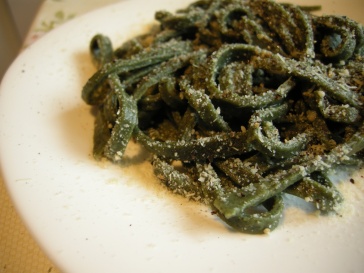When I was little, I loved to go tramping through the woods around my house to splash in the creek, blaze new trails along the blackberry briars, and see what forest treats I could eat. I knew of two things to look for: wild carrots and wild onions, and I searched diligently for as much of these as I could. I would arrive at the back door while my mom was cooking dinner and proudly present her with my contribution to the evening’s meal. The first couple of times it was probably cute, but after that, the novelty wore off, and, although I have recently been reassured of her occasional use of my foraging treasures, I’m sure lots of onion grass ended up in the compost.
In college I tried to develop a sincere interest in foraging, but my fear of misidentification and eventual pokeweed-induced death kept me from getting out there and harvesting free salad greens. I do remember laughing out loud when I saw dandelion greens packed in bags at the chichi health food store and sold for $4 a pop. Those, I’m not afraid of misidentifying.
Living in Bulgaria has reminded me that I can eat lots of things growing around – wild dock is all over the place, and it’s often used in salads or in place of spinach in banitsa. I’ve made an addictive pesto with wild garlic, and last year a friend presented me with a bagful of pungent mushrooms that she’d collected earlier that day. (Unfortunately they were too pungent for my taste, and I had to put them outside to turn back into humus.) Looking up ideas for dock, I stumbled on Sunny Savage’s website, Wild Food Plants, and I spent a good hour wandering around it. She’s got lots of videos on edible plant identification and methods of cooking, and I’m excited enough that I’m going to make an effort to take some classes on the subject when I get back to the U.S. I’ve really enjoyed discovering these new-to-me foods, and loved learning what I can do with them.
One thing Sunny talked about was making your own superfoods. If you’ve been within 50 feet of a health food store in the past five years, you know that superfoods are strange green powders sold for way too much money in the supplements section. You can make your own for free, simply by drying wild greens and buzzing them up in a spice grinder. I had some powdered nettle on hand (I bought it last year because I didn’t know what the Bulgarian word was on the packet, so I figured I’d drop fifty cents, take it home with me, and look it up in the dictionary. I have acquired a lot of things this way – maybe too many) and I’m still in use-it-don’t-lose-it mode, so I decided to whip together the homemade pasta recipe on her website. Why not? Seriously easy – an hour from measuring to eating, and even though I halved the receipe for myself (the full measurements are given below), I have plenty of pasta drying around my kitchen, for future use. And no, I don’t have a pasta maker. You’ve just got to roll the dough as thin as you can. Even thinner than I did – you can tell in the picture that it’s still on the portly side.

Nettle Pasta
1 1/2 cups all purpose flour
1/2 cup powdered nettle or other wild greens
2 eggs
4 tablespoons olive oil
2 teaspoons salt
In mixing bowl thoroughly mix flour and nettle powder. Make a well in the center and mix in remaining ingredients, working from the center, using your fingers. Knead until dough comes together, adding water by the tablespoon if necessary. Roll into ball and let dough rest, loosely covered, for at least 30 minutes. Roll out dough as thinly as possible and cut into pasta. (I used a pizza cutter.)
If you’re going to cook the pasta now, bring water, olive oil and salt to a rolling boil and submerge pasta for roughly 9 minutes. Strain and serve immediately. (I just tossed it with some butter, black pepper, and parmesan.) If you’re not going to eat it right away, hang it to dry!

Wow, that looks great! And you rolled it out by hand–I’m impressed. I won’t even make pasta with a machine, lol!
Sounds simple and delicious. I’m actually going to go foraging for ramp and fiddleheads this weekend. I’ll have to remember to take some gloves with me so I can pick some nettles while I’m there.
It looks so healthy!
I wish I have a pasta machine at home!
Wow, I love nettle, and it’s in season here in Serbia, so, will try 🙂
This looks and sound healthy – never tried green pasta. Looks delicious! I love nettle, especially stinging one, which is in abundance in my grandma’s countryside house in Azerbaijan. Nice recipe!
Thank you for the recipie, tried this and liked a lot! For the nettle powder I used dried nettles from the drug store, which I first crushed by hands and then sifted. The al dante version of the pasta needed less than 9 minutes to cook.
Elle – this was totally my first time making pasta, with or without a machine. Who knew it was so easy?
Norecipes – I look forward to seeing some fiddlehead pictures!
Cindy – no need for a pasta machine! Just roll it out really thin.
Marija – I’ve got your nettle fritters recipe flagged! Can’t wait to try it.
Farida – Any other quick ideas for it? I’m trying to use some up.
Eva – I’m so glad you liked it! Dried nettles at the drugstore? Where do you live?